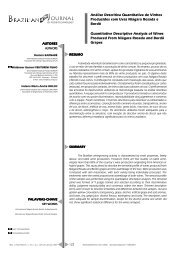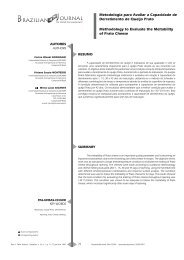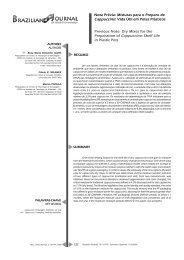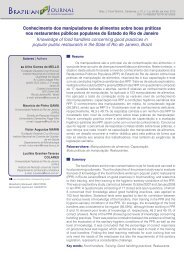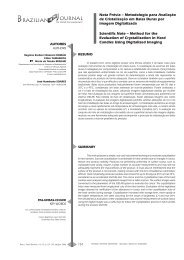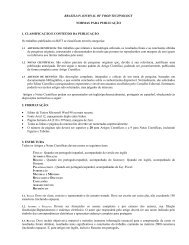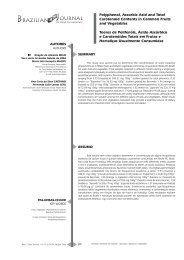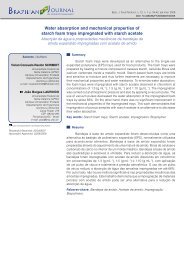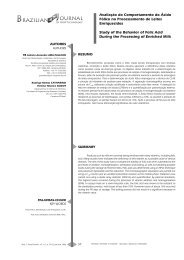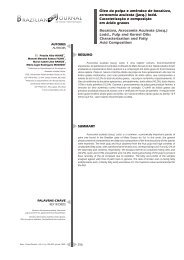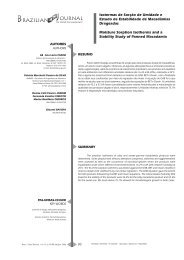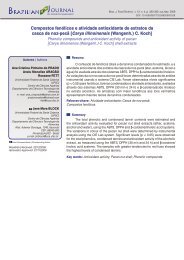Protein Quality and in Vivo Digestibility of Different Varieties of Bean ...
Protein Quality and in Vivo Digestibility of Different Varieties of Bean ...
Protein Quality and in Vivo Digestibility of Different Varieties of Bean ...
Create successful ePaper yourself
Turn your PDF publications into a flip-book with our unique Google optimized e-Paper software.
CRUZ, G.A.D.R. et al.<br />
<strong>Prote<strong>in</strong></strong> <strong>Quality</strong> <strong>and</strong> <strong>in</strong> <strong>Vivo</strong> <strong>Digestibility</strong><br />
<strong>of</strong> <strong>Different</strong> <strong>Varieties</strong> <strong>of</strong> <strong>Bean</strong> (Phaseolus<br />
vulgaris L.)<br />
1. INTRODUCTION<br />
The legume seeds are widely consumed around the<br />
world <strong>and</strong> the acceptability depends on the climatic conditions<br />
<strong>in</strong> the area. In Lat<strong>in</strong> America, beans (Phaseolus vulgaris) are the<br />
most consumed legume, supply<strong>in</strong>g considerable amounts <strong>of</strong><br />
nutrients to the diet <strong>of</strong> undernourished people (COELHO, 1991).<br />
BRESSANI et al. (1988) observed that besides <strong>in</strong>creas<strong>in</strong>g the<br />
prote<strong>in</strong> content <strong>of</strong> the meal, beans have contributed to<br />
improv<strong>in</strong>g the prote<strong>in</strong> quality <strong>of</strong> the diet by a factor <strong>of</strong> about 50<br />
to 70%, when constituted predom<strong>in</strong>antly <strong>of</strong> legumes <strong>and</strong> cereals,<br />
because bean prote<strong>in</strong>s are rich <strong>in</strong> lys<strong>in</strong>e, complement<strong>in</strong>g prote<strong>in</strong>s<br />
from cereals such as rice or corn, well known for be<strong>in</strong>g deficient<br />
<strong>in</strong> this am<strong>in</strong>o acid. This fact means beans are <strong>of</strong> exceptional<br />
nutritional importance, especially when the restricted <strong>in</strong>gestion<br />
<strong>of</strong> food <strong>of</strong> animal orig<strong>in</strong> among the low <strong>in</strong>come population is<br />
considered, to whom the legume is a daily food.<br />
Rice <strong>and</strong> beans are the staple foods <strong>of</strong> the Brazilian diet<br />
<strong>and</strong> mixed <strong>in</strong> adequate proportion, they may improve the<br />
biological value <strong>of</strong> the prote<strong>in</strong>s consumed (VIEIRA, 1992).<br />
The genus Phaseolus <strong>in</strong>cludes all species known as<br />
beans. The species Phaseolus vulgaris L. is the most common<br />
<strong>and</strong> <strong>in</strong>cludes many varieties such as “Carioca”, “Roxo” (Purple),<br />
“Mulat<strong>in</strong>ho” (Brown), “Preto” (Black) <strong>and</strong> others (KANAMORI<br />
et al., 1982).<br />
Although represent<strong>in</strong>g an important source <strong>of</strong> prote<strong>in</strong>s,<br />
starch, vitam<strong>in</strong>s, m<strong>in</strong>erals <strong>and</strong> fiber (COELHO, 1991; GEIL;<br />
ANDERSON, 1994; BARAMPANA; SIMARD, 1994; MARTINEZ<br />
et al., 1998) bean nutrients are not readily available for use by<br />
the organism (EVANS; BAUER, 1978; SARWAR; PEACE, 1986;<br />
RODRIGUES, 1995; CARBONARO et al., 1997).<br />
<strong>Digestibility</strong> is the first factor affect<strong>in</strong>g the efficiency <strong>of</strong><br />
diet prote<strong>in</strong>s. When certa<strong>in</strong> peptide l<strong>in</strong>ks are not hydrolysed <strong>in</strong><br />
the digestive process, part <strong>of</strong> the prote<strong>in</strong> is either excreted <strong>in</strong><br />
the faeces, or transformed <strong>in</strong>to a metabolic product by<br />
microorganisms present <strong>in</strong> the large <strong>in</strong>test<strong>in</strong>e (SGARBIERI;<br />
WHITAKER, 1982). One <strong>of</strong> the major limitations <strong>of</strong> beans is the<br />
low nutritional value <strong>of</strong> their prote<strong>in</strong>s, due to their poor<br />
digestibility <strong>and</strong> reduced content <strong>of</strong> sulphur am<strong>in</strong>o acids<br />
(NIELSON, 1991; BRESSANI, 1993; GENOVESE; LAJOLO, 1996,<br />
1998). Besides reduced sulphur am<strong>in</strong>o acid contents, they also<br />
show reduced bioavailability (SGARBIERI; WHITAKER, 1982).<br />
The low biological usage <strong>of</strong> bean prote<strong>in</strong>s is attributed<br />
to many factors such as: compact structure <strong>of</strong> the native<br />
prote<strong>in</strong>s which may resist proteolysis; anti-nutritional<br />
compounds which can modify the digestibility, alter<strong>in</strong>g the<br />
liberation <strong>of</strong> am<strong>in</strong>o acids <strong>and</strong> high excretion <strong>of</strong> endogenous<br />
nitrogen (WU; KUNKEL, 1995).<br />
In general, the digestibility <strong>of</strong> bean prote<strong>in</strong>s can be<br />
improved by thermal treatment (WU et al., 1974). However,<br />
studies <strong>in</strong>dicate that the digestibility is limited, even after<br />
thermal treatment, due to the primary conformation <strong>of</strong> the<br />
prote<strong>in</strong>s <strong>and</strong>/or to the presence <strong>of</strong> some components <strong>of</strong> the<br />
seed, such as thermo-stable protease <strong>in</strong>hibitors <strong>and</strong><br />
polyphenols which complex with digestive enzymes <strong>and</strong>/or<br />
with bean prote<strong>in</strong>s, reduc<strong>in</strong>g their susceptibility to hydrolysis<br />
(RODRIGUES; LAJOLO, 1993).<br />
An improvement <strong>of</strong> digestibility does not necessary<br />
imply an <strong>in</strong>crease <strong>in</strong> prote<strong>in</strong> quality, such that the am<strong>in</strong>o acids<br />
can be better absorbed, but not take part <strong>in</strong> prote<strong>in</strong> synthesis,<br />
due to the deficiency <strong>of</strong> some essential am<strong>in</strong>o acids. The<br />
nutritional value <strong>of</strong> a food is <strong>in</strong>dicated by its chemical<br />
composition, although this does not characterize the food from<br />
the nutritional po<strong>in</strong>t <strong>of</strong> view. Food nutrients are available to<br />
the organism <strong>in</strong> their totality, only after their <strong>in</strong>gestion<br />
(SGARBIERI, 1989). Hence, biological analyses such as PER, NPR<br />
<strong>and</strong> NPU, which evaluate the prote<strong>in</strong> quality based on the<br />
organism’s response to the prote<strong>in</strong> <strong>in</strong>gestion, are important<br />
tools for better food characterization.<br />
Several varieties <strong>of</strong> bean with great agricultural potential<br />
have been obta<strong>in</strong>ed from genetic breed<strong>in</strong>g studies. Among<br />
these varieties are some that st<strong>and</strong> out due to the presence <strong>of</strong><br />
more favourable characteristics, <strong>and</strong> thus deserve more attention<br />
for nutritional studies. Thus, the purpose <strong>of</strong> the present study<br />
was to evaluate the prote<strong>in</strong> quality <strong>of</strong> the cultivars, A774, Carioca,<br />
Diamante Negro, Ouro Branco, RAO 33 <strong>and</strong> Vermelho Coimbra.<br />
These cultivars were k<strong>in</strong>dly supplied by the Centro Nacional de<br />
Pesquisa de Arroz e Feijão da Empresa Brasileira de Pesquisa<br />
Agropecuária (EMBRAPA – CNPAF).<br />
2. MATERIALS AND METHODS<br />
2.1 Genetic material<br />
The bean samples (Phaseolus vulgaris L.) <strong>of</strong> the varieties<br />
“A774” (brown group), “Carioca” (Carioca group), “Diamante<br />
Negro” (black group), “Ouro Branco” (white group), “RAO”<br />
33 (purple group) <strong>and</strong> “Vermelho Coimbra” (red group) were<br />
obta<strong>in</strong>ed from the Empresa Brasileira de Pesquisa Agropecuária<br />
(EMBRAPA/CNPAF), Goiânia, GO, Brazil.<br />
2.2 Preparation <strong>of</strong> bean flour<br />
For the preparation <strong>of</strong> whole cooked flour, the gra<strong>in</strong>s<br />
were cleaned <strong>and</strong> cooked <strong>in</strong> water <strong>in</strong> the proportion <strong>of</strong> 1:1.5<br />
(w/v) <strong>in</strong> a pressure cooker for forty m<strong>in</strong>utes. The gra<strong>in</strong>s were<br />
then dried <strong>in</strong> an air circulat<strong>in</strong>g oven (24 h / 60 o C) <strong>and</strong> ground<br />
<strong>in</strong> a mill.<br />
2.3 Preparation <strong>of</strong> the diets<br />
The composition <strong>of</strong> the experimental diets is shown <strong>in</strong><br />
Table 1. Diets 1 to 6 were prepared by us<strong>in</strong>g bean samples as<br />
prote<strong>in</strong> sources. Diet 7 (case<strong>in</strong>) was the st<strong>and</strong>ard <strong>and</strong> diet 8<br />
was the prote<strong>in</strong> free diet.<br />
The nitrogen content <strong>of</strong> the mixture was determ<strong>in</strong>ed<br />
by the semi-micro Kjeldahl method us<strong>in</strong>g the factor 6.25 to<br />
obta<strong>in</strong> the prote<strong>in</strong> content (AOAC, 1984).<br />
Braz. J. Food Technol., v.6, n.2, p.157-162, jul./dez., 2003 158



